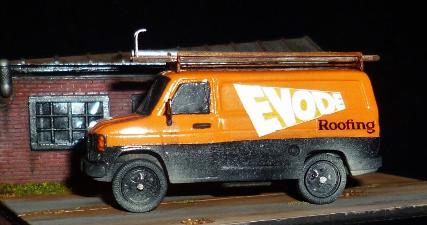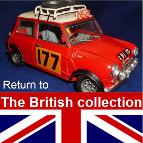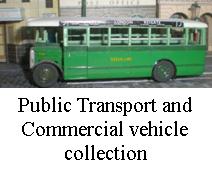
1979 Ford Transit (1st generation facelift version, commonly known as the MkII)
In 1965 Ford was in the process of merging the British, German and Irish divisions of the Ford Motor Company, a process that would be finalised in 1967 with the formation Ford of Europe. The first vehicle to be released in co-operation between the members was the Transit van, officially born in 1965.
The Transit was a modern marvel, a huge step forward from the Ford Thames van it replaced and the Commer and Bedford CA vans it was competing against. It’s flexibility, comfort and ease of use were such a revelation the Transit was an immediate success and soon a familiar sight on British roads and became a byword for all light commercial vans.
Today there is hardly a company in Britain that hasn’t used a Transit based vehicle. A cargo van in short and long wheel base, a minibus, cutaway van chassis, a drop-side pickup truck, recovery vehicles, food vendors, the list of Transit chassis applications is huge making it a bedrock of local commerce and allowing Ford to Market the van as “the backbone of Britain”.
It was such a strong and well performing vehicle it proved a perfect platform for crime too, becoming the most frequently stolen vehicle and then turning up having been used in a smash and grab or other form of crime requiring a high load capacity and speedy getaway performance.
Originally marketed throughout Western Europe the Transit would go on to conquer the world.
The 1965 Transit had a short bonnet hiding a shorter V4 engine giving it a short snub-nosed look. The cab was very well appointed and the cargo space better than anything in its class.
These features were further enhanced with the face lifted version which went on sale in August, 1977. The second-generation Transit ran from 1977 to 1986 was officially called the "Transit 1978 1⁄2" but to the man on the street it was simply, the Mark 2.
The mechanicals were modernised and the Pinto engine from the Cortina was added, there was even a V6 engine available in the range. The front end was given a makeover with a new grey plastic front grille and integrated headlamp surrounds, wraparound indicators and longer bumper end caps. At the rear the light clusters were now multifunction units incorporating fog, indicator, reversing and side lights. The interior was updated to with a new dash, more ergonomically arranged layout comfortable seats and generally better-appointed panels.
The Transit was made available in 6 body styles, two wheelbase lengths, 32 door combinations, 6 axle ratios, options for 12 – 17 interior seats and a selection of 5 engines. Late in 1982 there was even a four-wheel drive option. All of these were available in the Ford customisation plan and it was this huge flexibility which was a factor in the success of the Transit. This was now the van be seen in and is perhaps the model that, thanks to films and tv programs, the is best remembered shape when people talk of the transit van.
Transits have been assembled in Belgium, the Netherlands, New Zealand, Turkey and principally Southampton were the 2,000,000th Transit was produced on the 25th of July, 1985.
Since the original Transit launch in 1965, over fifty years ago, the Transit has proved its popularity with over 8 million units having been sold. A figure that makes it the the third best-selling van of all time. While it might not be the most glamorous vehicle it is surely the most flexible and adaptable, but what really sets it apart is the ease of use and the almost car-like performance.
Initially produced for the European market, sales and production spread across Asia and eventually went worldwide in 2013 when Ford of America replaced the E-Series with Transits. It was a success in the US too being voted 2nd in Motor Trend's 2015 'Truck of the Year' award and best-selling van in 2016.
Lovers of the Transit formed the Transit Van Club in 2005, over 1,800 dedicated Transit enthusiasts are restoring the rare models and championing the cause of the newest ones.
A short history of Evode
In 1932 Adolph Axelrath, owner of the German firm, Yankee Polish Company, and Henry Bostock of Stafford’s Lotus Ltd. shoe makers, agreed to set up a new firm to manufacture and sell shoe polishes in Lotus & Delta shops. On the 3rd of June “Spic and Span Shoe Polishes Ltd” set up in Glover street, Stafford.
Sadly, the company was not successful and the Bostock family wanted to liquidate the firm during 1937, Mr Axelrath was of a different opinion and started looking at alternatives. He met with Dr Hermann Simon and engaged him to take over the running of the company. Dr Simon, a German Jew wants to flee Nazi Germany and emigrated to Britain with his family in 1938 and joined the Spic & Span company as director and chief chemist in January 1938.
Under the direction of Dr Simon the company became Spic and Span Chemical Products Limited and started work on a range of adhesives and sealants for use in the world of construction. In October of 1838 the firm changed its name a second time. This time it was to build on the reputation of the company’s best-known product, Dove shoe polish; Dove Chemical Products Ltd. was born. Dr Simon started steering the firm toward a growing range of chemicals, waterproofing & bitumen products.
Come the Second World War and Dr Simon’s life and work was to be interrupted. Being a German national in Britain he was considered an ‘enemy alien’; and he was interned on the Isle of Man. In his absence it was found that the name of the firm infringed the trade mark rights of another company forcing the firm to change its name again. They directors decided to reverse the name of the firm in February 1940. Reversing the letters of dove and appending it with an 'E' so that alphabetically the firm would come up early in lists, Dove to Evode. Evode Chemical Works Limited was born and would become one of Stafford’s most famous firms. At the same time the works were mover to a derelict shoe factory at 22 Stone Road, Stafford, due to “wartime considerations”.
The loss of Dr Simon's expertise was a problem and a in the August of 1940 a plea was submitted to the House of Lords outlining the benefits Dr Simon could bring to the war effort in regards to concrete and building technology and the positive effects he would have on manufacture of airfield runways, water storage facilities and gas-proof stores. The plea was successful and Dr Simon returned to Evode. In turn, Evode supplied the government with paints, waterproofing compounds and sealants to aid the British war effort.
After the war Evode returned to the Glover St premises and continued it’s work leading to the development of Evo-Stik Impact and 528 adhesives. Evo-stik being registered in 1947 and becoming a worldwide brand. Then came the 'Great fire of Glover Street' in 1952 which was a major event in the town. The laboratories were damaged but fortunately none of the formulations were lost. The company regrouped and started building a new works complex off the Common Road, Stafford in 1956. From this base the firm grew rapidly propelled by the use of television adverts and 15 licensee agreements around the world. Being able to bring in an increasing number of technical staff meant that many new products were added to the range, many becoming household names of the time, like Evo-Stik Resin 'W' and Flashband.
In 1963 Evode Holdings Limited became a publicly quoted company and ten years later, in October 1973, the Roof Waterproofing Division was formed into a new firm, Evode Waterproofing Systems Ltd. This firm not only sold the company’s roof waterproofing products by applied mastics and sealants too. In March 1978 the company changed its name to the simpler Evode Roofing Ltd. and in the July of 1978 released its latest product, Tekurat, an insulation product. This product evolved into a separate firm, Tekurat Insulations Ltd., in 1981, of which the Evode Group held 51% of the shares.
Evode Roofing Ltd. expanded over the next few years acquiring Stafford Roofing Ltd and Staffordshire Roof Tiling Ltd but in 1987 the Evode Group sold the firm, along with Evode Joint Sealing Ltd and Tekurat Insulations Ltd to a “Tarmac” subsidiary BriggsAmascoLtd who change the company name to Hyflex Roofing Ltd.
The rest of the Evode group passed through a number of different firms including Laporte, Elf and Ato Findley. The Evode trading name was generally retained but diluted until Ato Findley merged with Bostik in June 2000 becoming Bostik Findley from 1st January 2001. The Evode brand was gone, only Evo-Stik remaining on the catalogue, a lingering reminder of the once great Evode company of Stafford.









This kit was bought in a sale from a trader at the South Cheshire Militaire show many years ago. It is white metal, end of run quality casting and nothing actually fitted. Not clear parts, no decals and so low on detail there wasn’t even a steering wheel. It was packaged in a clear bag. In the bag was a small piece of white paper with the designation of the model, and OO-HO scale typed on it (yes, typed! The pressure marks are clear in the paper) but no further information.
The manufacturer of this kit remains a mystery, if you know please share the information with us.
At the time the Museum didn’t have a transit van and the prices of rare OOP ESCI kits were up in the £80 level. Thank you Italeri for re-releasing this kit and bringing the prices back down to a fair level (around £25 at the time of writing in 2018).
When IPMS Stafford put forward a theme of celebrating Staffordshire for their 2018 Scale Model World show a photo of an “Evode” transit popped up and Ian decided to dig out the kit.
Ian cleaned up most of the parts but soon realised that they would need a lot of filling sanding, priming sanding, more priming and much more sanding before the model would look anywhere like presentable. And the cab was moulded with a separate roof and pillars form that meant the interior would have to be painted and masked prior to working on the exterior.
Fortunately, the cab interior was sufficiently detailed with seats and dash for what was needed and easy enough to paint as it was. But the lack a steering wheel really stood out. For the moment Ian focused on getting the chassis, cab, roof, rear doors and van sides all put together. As mentioned, nothing fitted, but It was coaxed together and plenty of fillers put in.
The steering wheel was built up from plastic tube and rod, painted and set in position. That done the cab roof went on only to find there was a huge step between the cab roof and the van roof; more sanding, filling, sanding…….
Masking the cab windows to protect the painted interior allowed for priming of the exterior, and more sanding and priming. After much work the step in the roof was eradicated and the shape and surface became acceptable.
Wheels and tyres were very poor in that there were moulded on tyres that looked less than “Dinky” in their lack of reality. Ian ordered a garage forecourt set that included tyres for the model, filed off the kit tyres and adjusted the new tyres to fit.
Finally glazing was added from scratch before being masked so that body colours could be added. The primer used was Alclad 2 black primer and microfiller, Zero gloss black and an orange from the Deco-Art range was applied by airbrush. The body colours were sealed with a gloss coat from the Zero paints range. All other detail painting was by brush using Citadel and Deco-Art acrylics supported by Humbrol enamels.
Decals had to be home made and after application were sealed with “Klear” floor polish.
Finally, the roof rack and load were built up from scratch. Rope was made from long strands of very fine wire twisted up to give the rope effect.
For the sake of presentation a background base was made to give the impression of the industrial nature of the “Evode” chemical works in Stafford, Staffordshire. This utilised the many spares Ian was given by Terry Campion when his brother Ian Terry past away. Both members of IPMS Stafford, like Ian, it is fitting to remember Ian Campion and the loss of Evode as a UK company at the same time.

